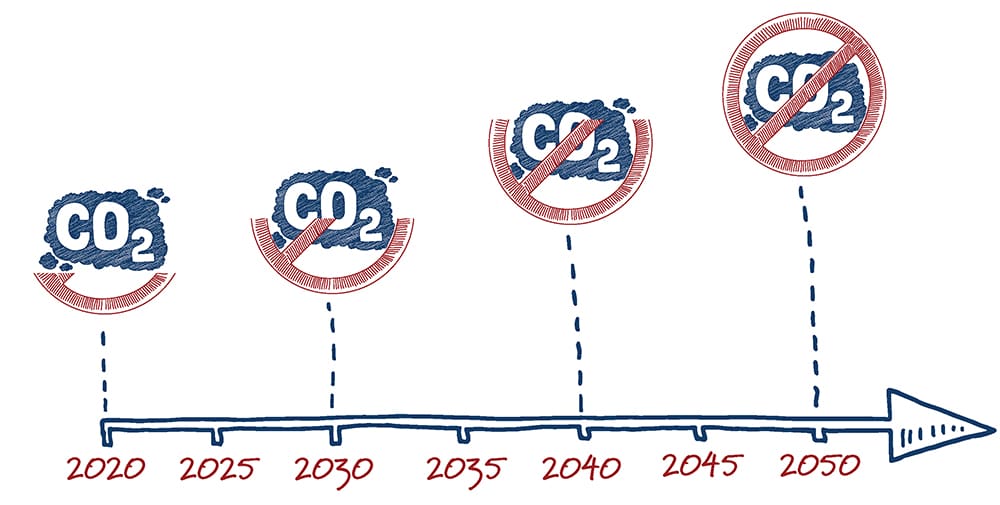Posted on October 9, 2019 by Jay Faison and Rich Powell
North Carolina utility, Duke Energy announced a bold plan to decrease carbon emissions 50 percent by 2030 and ultimately be net-zero by 2050. This means the company would be among the first major investor-owned U.S. utilities to set forth an ambitious plan to transition to clean energy.
After demonstrating that clean resources are market-competitive energy solutions for customers, the path to achieve emissions reductions is more clear and a long-term commitment to clean generation was needed. The company’s 24 million customers across six states have already seen a 31% percent reduction in emissions since 2005 by receiving more of their energy from cost-effective carbon-free power — primarily nuclear, hydro, natural gas, wind and solar.
We applaud Duke's plan to utilize all clean energy sources to reach their commitment and their intention to lean in on energy innovation to create the new technologies needed to achieve their goal. Their plan notes that they know how to achieve a 50% reduction in emissions with existing clean technologies but also recognizes the need for new technologies to emerge to ensure a clean and affordable path to a net-zero power system by 2050. This is a realistic perspective that underscores the need for innovation in the sector and we are glad Duke is making innovation a priority.
Further, the natural gas revolution right here in the United States has already lowered power prices AND cut grid emissions by 20% single-handedly. Duke recognizes that natural gas infrastructure will be required to fuel this transition to a low-carbon future and will be deploying natural gas to maintain reliability while also expanding energy storage, energy efficiency and infrastructure capacity.
There are exciting options for new zero-emission natural gas plants, such as the NET Power pilot plant near Houston, TX which will allow using our natural gas abundance well into a clean energy future. NET Power LLC is a Durham, North Carolina-based company owned by 8 Rivers Capital LLC and they have pioneered new technology to capture all carbon dioxide air emissions that can then be safely buried underground or used to great products like building materials or carbon fiber. A generous new federal tax incentive for carbon capture signed into law last year might make the clean fossil fuel route Duke’s best bet for affordable 24/7 power.
While Duke is planning to invest $10 billion to double their wind and solar portfolio by 2030 if not before, they will also continue to operate their existing carbon-free technologies, including nuclear and hydro. Nuclear power produces carbon-free energy, runs 24/7 and is incredibly resilient in the face of increasing natural disasters. This is particularly important as Duke’s nuclear fleet creates more than 11,000 megawatts of carbon-free generation in the Carolinas -- enough energy to serve 8.8 million homes. Keeping these plants open also helps support innovation in the nuclear space in North Carolina - which is home to many start-ups that are focused on fourth generation nuclear power plants.
Hydropower is the renewable source with the best track record of reducing emissions in the U.S. and abroad. It's clean, safe, and dispatchable when we need it. The U.S. hydropower fleet produces enough clean electricity to power more than 20 million households each year, making it the fourth largest electricity source after natural gas, coal and nuclear. In the North Carolina, hydro produces 10% of clean electricity generation in the state.
Seeing private industry take big bold steps with market based solutions that will also make sense for consumers is the right path to take us through this transition. But we should also continue advocating for sound public policy at the federal and state levels that advances technology and innovation. This includes longer-lasting battery storage, new nuclear technologies and effective ways to capture carbon emissions.
Duke Energy is Committed to Net Zero Carbon Emissions by 2050

With their bold commitment to net zero carbon emissions by 2050, Duke continues to lead in American power. Market signals like these demonstrate that transitioning to clean energy can be as positive for affordability and reliability as it is for addressing climate change.
We look forward to working alongside Duke to encourage federal investments in clean technology. Innovations in advanced nuclear, carbon capture for coal and gas, and battery storage will ensure this clean path is affordable for consumers.
View more news on power company commitments to lowering emissions:
National Journal: Power-Sector Climate Pledges Revive Debate Over Clean-Energy Mandates
Colorado Springs Gazette: GUEST COLUMN: Xcel taking a bold step into the unknown
View more of Our Take and let us know what you think at jaylistens@clearpath.org.
